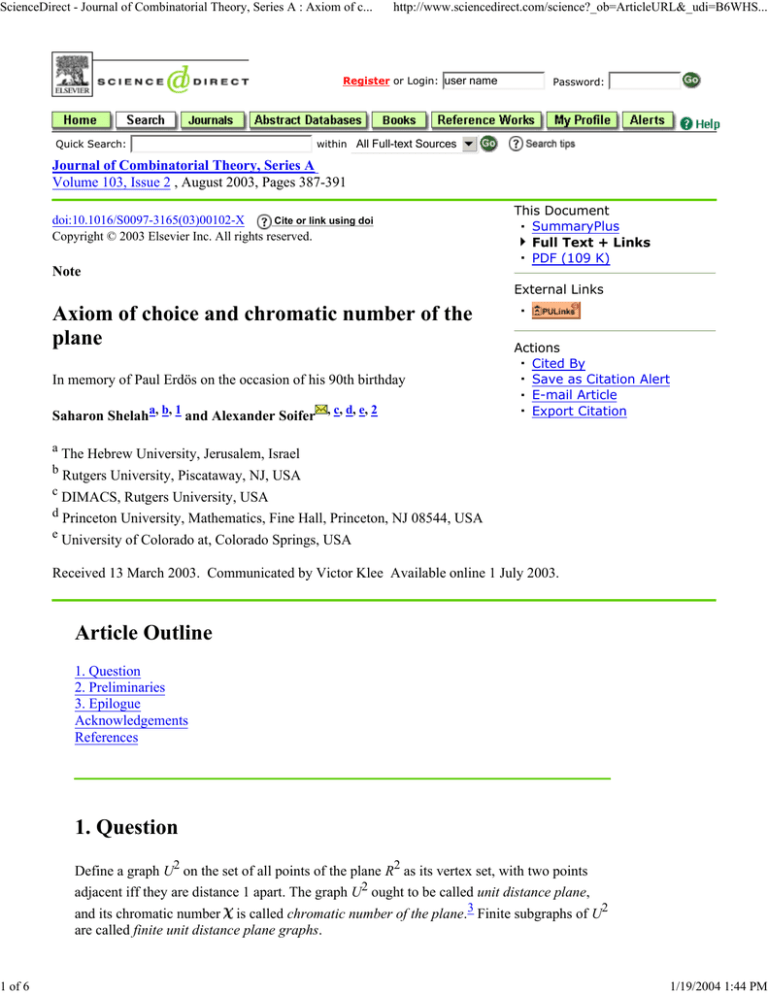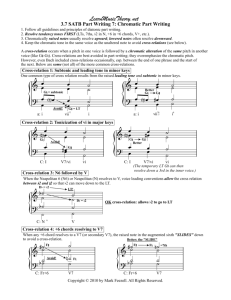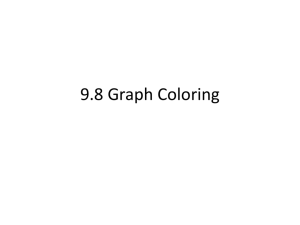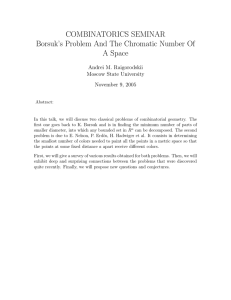
ScienceDirect - Journal of Combinatorial Theory, Series A : Axiom of c...
1 of 6
http://www.sciencedirect.com/science?_ob=ArticleURL&_udi=B6WHS...
Register or Login: user name
Quick Search:
within All Full-text Sources
Password:
6
Journal of Combinatorial Theory, Series A
Volume 103, Issue 2 , August 2003, Pages 387-391
Cite or link using doi
doi:10.1016/S0097-3165(03)00102-X
Copyright © 2003 Elsevier Inc. All rights reserved.
This Document
SummaryPlus
Full Text + Links
PDF (109 K)
Note
External Links
Axiom of choice and chromatic number of the
plane
In memory of Paul Erdös on the occasion of his 90th birthday
Saharon Shelaha, b, 1 and Alexander Soifer , c, d, e, 2
a
The Hebrew University, Jerusalem, Israel
b
Rutgers University, Piscataway, NJ, USA
c
DIMACS, Rutgers University, USA
d
Princeton University, Mathematics, Fine Hall, Princeton, NJ 08544, USA
e
University of Colorado at, Colorado Springs, USA
Actions
Cited By
Save as Citation Alert
E-mail Article
Export Citation
Received 13 March 2003. Communicated by Victor Klee Available online 1 July 2003.
Article Outline
1. Question
2. Preliminaries
3. Epilogue
Acknowledgements
References
1. Question
Define a graph U2 on the set of all points of the plane R2 as its vertex set, with two points
adjacent iff they are distance 1 apart. The graph U2 ought to be called unit distance plane,
and its chromatic number is called chromatic number of the plane.3 Finite subgraphs of U2
are called finite unit distance plane graphs.
1/19/2004 1:44 PM
ScienceDirect - Journal of Combinatorial Theory, Series A : Axiom of c...
2 of 6
http://www.sciencedirect.com/science?_ob=ArticleURL&_udi=B6WHS...
In 1950 the 18-year old Edward Nelson posed the problem of finding (see the problem's
history in [Soi1]). A number of relevant results were obtained under additional restrictions on
monochromatic sets (see surveys in [CFG, KW, Soi2 and Soi3]). Falconer, for example,
showed [F] that is at least 5 if monochromatic sets are Lebesgue measurable. Amazingly
though, the problem has withstood all assaults in the general case, leaving us with an
embarrassingly wide range for being 4, 5, 6 or 7.
In their fundamental 1951 paper [EB], Erdös and de Bruijn have shown that the chromatic
number of the plane is attained on some finite subgraph. This result has naturally channeled
much of research in the direction of finite unit distance graphs. One limitation of the
Erdös–de-Bruijn result, however, has remained a low key: they used quite essentially the
axiom of choice. So, it is natural to ask, what if we have no choice? Absence of choice––in
mathematics as in life––may affect outcome.
We will present here an example of a distance graph on the line R, whose chromatic number
depends upon the system of axioms we choose for set theory. While the setting of our
example differs from that of the chromatic number of the plane problem, the example
illuminates how the value of chromatic number can be dramatically affected by the inclusion
or the exclusion of the axiom of choice in the system of axioms for sets.
Finally, we formulate a Conditional Chromatic Number Theorem, which specifically
describes a setting in which the chromatic number of the plane takes on two different values
depending upon the axioms for set theory.
2. Preliminaries
Let us recall basic set-theoretic definitions and notations. In 1904 Zermelo [Z] formalized the
axiom of choice that had previously been used informally:
Axiom of choice (AC). Every family of nonempty sets has a choice function, i.e., there is a
function f such that f(S) S for every S from .
Many results in mathematics really need just a countable version of choice:
Countable axiom of choice (AC 0). Every countable family of nonempty sets has a choice
function.
In 1942 Bernays [B] introduced the following axiom:
Principle of dependent choices (DC). If E is a binary relation on a nonempty set A, and for
every a A there exists b A with aEb, then there is a sequence a1,a2,...,an,... such that
anEan+1 for every n< .
AC implies DC (see Theorem 8.2 in [J], for example), but not conversely. In turn, DC
implies AC 0, but not conversely. DC is a weak form of AC and is sufficient for the classical
theory of Lebesgue measure. We observe that, in particular, DC is sufficient for Falconer's
result [F] formulated in Question above.
We will make use of the following axiom:
(LM) Every set of real numbers is Lebesgue measurable.
As always, ZF stands for Zermelo–Fraenkel system of axioms for sets, and ZFC for
Zermelo–Fraenkel with the addition of the axiom of choice.
1/19/2004 1:44 PM
ScienceDirect - Journal of Combinatorial Theory, Series A : Axiom of c...
3 of 6
http://www.sciencedirect.com/science?_ob=ArticleURL&_udi=B6WHS...
Assuming the existence of an inaccessible cardinal, Solovay constructed in 1964 (and
published in 1970) a model that proved the following consistency result [Sol]:
Solovay Theorem. The system of axioms ZF + DC + LM is consistent.
As Jech [J] observes, in the Solovay model, every set of reals differs from a Borel set by a set
of measure zero.
Finally, we say a set X R has the Baire property if there is an open set U such that X U
(symmetric difference) is meager, (or of first category), i.e., a countable union of nowhere
dense sets.
Example. We define a graph G as follows: the set R of real numbers serves as the vertex set,
.
and the set of edges is
Claim 1. In ZFC the chromatic number of G is equal to 2.
Proof. Let
. We define an equivalence relation E on R as
follows: sEt s-t S, Let Y be a set of representatives for E. For t R let y(t) Y be such that
tEy(t). We define a 2-coloring c(t) as follows: c(t)=l, l=0, 1 iff there is n Z such that
.
Without AC the chromatic situation changes dramatically:
Claim 2. In ZF+AC 0+LM the chromatic number of the graph G cannot be equal to any
positive integer n nor even to 0.The proof of Claim 2 immediately follows from the first of
the following two statements:
1. If A1,...,An,... are measurable subsets of R and
contains two adjacent vertices of the graph G.
, then at least one set An
2. If A [0,1) and A contains no pair of adjacent vertices of G then A is null (of Lebesgue
measure zero).
Proof. We start with the proof of statement 2. Assume to the contrary that A contains no pair
of adjacent vertices of G yet A has positive measure. Then there is an interval I such that
(2.1)
Choose q Q such that
Then
. Let
.
(2.2)
Inequalities ((2.1) and (2.2)) imply that there is x I A B. As x B, we have
. So, we have x,y A and
. Thus, {x,y} is an edge
of the graph G with both endpoints in A, which is the desired contradiction. The proof of the
and Lebesgue measure is a countably
statement 1 is now obvious. Since
additive function in AC 0, there is a positive integer n such that An is a non-null set of reals.
By statement 2, An contains a pair of adjacent vertices of G as required.
1/19/2004 1:44 PM
ScienceDirect - Journal of Combinatorial Theory, Series A : Axiom of c...
4 of 6
http://www.sciencedirect.com/science?_ob=ArticleURL&_udi=B6WHS...
Remark. We can replace ZF + LM by ZF + "every set of real numbers has the property of
Baire."
3. Epilogue
Is AC relevant to the problem of chromatic number of the plane? The answer depends
upon the value of which we, of course, do not know yet. However, the presented here
example points out circumstances in which AC would be quite relevant. We have the
following conditional result to report.
Conditional Theorem. , 4 Assume that any finite unit distance plane graph has chromatic
number not exceeding 4. Then:
In ZFC the chromatic number of the plane is 4.
In ZF+DC+LM the chromatic number of the plane is 5, 6 or 7.
Proof. Claim (*) is true due to [EB]. The system ZF + DC + LM implies that every subset S
of the plane R2 is Lebesgue measurable. Indeed, S is measurable iff there is a Borel set B
such that the symmetric difference S B is null. Thus, every plane set differs from a Borel set
by a null set. We can think of a unit segment I=[0,1] as a set of infinite binary fractions and
I2 defined as 0.a1a2...an... (0.a1a3...;0.a2a4...) preserves null
observe that the bijection I
sets. Due to Falconer result [F] formulated in the Question above, we can now conclude that
the chromatic number of the plane is at least 5.
Perhaps, the problem of finding the chromatic number of the plane has withstood all assaults
in the general case, leaving us with a wide range for being 4, 5, 6 or 7 precisely because
the answer depends upon the system of axioms we choose for set theory?
Acknowledgements
The authors thank the referee for kind words and suggested improvements in style. A.S.
thanks Robert M. Solovay, Thomas J. Jech, Edward Nelson, and András Hajnal for e-mails
and conversations.
References
B. P. Bernays, A system of axiomatic set theory III. J. Symbolic Logic 7 (1942), pp. 65–89.
MathSciNet
CFG. H.T. Croft, K.J. Falconer and R.K. Guy. Unsolved Problems in Geometry, Springer,
New York (1991).
EB. P. Erdös and N.G. de Bruijn, A colour problem for infinite graphs and a problem in the
theory of relations. Indag. Math. 13 (1951), pp. 371–373.
F. K.J. Falconer, The realization of distances in measurable subsets covering Rn. Comm.
Theory (A) 31 (1981), pp. 187–189.
1/19/2004 1:44 PM
ScienceDirect - Journal of Combinatorial Theory, Series A : Axiom of c...
5 of 6
http://www.sciencedirect.com/science?_ob=ArticleURL&_udi=B6WHS...
J. T.J. Jech. The Axiom of Choice, North-Holland, Amsterdam (1973).
KW. V. Klee, S. Wagon, Old and new Unsolved Problems in Plane Geometry and Number
Theory, The Mathematical Association of America, Washington DC, 1991.
Soi1. A. Soifer, Chromatic number of the plane & its relatives. Part I: the problem & its
history. Geombinatorics XII 3 (2003), pp. 131–148.
Soi2. A. Soifer, Chromatic number of the plane & its relatives. Part II: polychromatic
number & 6-coloring. Geombinatorics XII 4 (2003), pp. 191–216.
Soi3. A. Soifer, Mathematical coloring book, CEME, Colorado Springs, to appear.
Sol. R.M. Solovay, A model of set theory in which every set of reals is Lebesgue
measurable. Ann. of Math. (Ser. 2) 92 (1970), pp. 1–56. MathSciNet
Z. E. Zermelo, Beweis dass jede Menge wohlgeordnet warden kann. Math. Ann. 59 (1904),
pp. 514–516.
1
This is Publication E33.
2
Thanks Rutgers University for a travel grant that facilitated this joint research, DIMACS
for a Long Visitor appointment, and Princeton University for a Visiting Fellowship.
3
Chromatic number (G) of a graph G is the smallest number of colors required for coloring
the vertices, so that no two vertices of the same color are connected by an edge.
4
We assume the existence of an inaccessible cardinal. A cardinal is called inaccessible if
> 0, is regular, and is strong limit. An infinite cardinal
is regular, if cf
= .A
cardinal
is a strong limit cardinal if for every cardinal , < implies 2 < .
Journal of Combinatorial Theory, Series A
Volume 103, Issue 2 , August 2003, Pages 387-391
This Document
SummaryPlus
Full Text + Links
PDF (109 K)
External Links
Actions
Cited By
Save as Citation Alert
E-mail Article
Export Citation
1/19/2004 1:44 PM
ScienceDirect - Journal of Combinatorial Theory, Series A : Axiom of c...
6 of 6
http://www.sciencedirect.com/science?_ob=ArticleURL&_udi=B6WHS...
Send feedback to ScienceDirect
Software and compilation © 2004 ScienceDirect. All rights reserved.
ScienceDirect® is a registered trademark of Elsevier B.V.
Your use of this service is governed by Terms and Conditions. Please review our Privacy Policy for details on how we protect
information that you supply.
1/19/2004 1:44 PM







